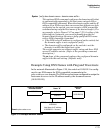
Troubleshooting
DNS Resolver
■ When the switch is configured with both of the following:
• the IP address of a DNS server available to the switch
• the domain suffix of a domain available to the configured DNS
server
then:
• A DNS-compatible command that includes the host name of a
device in the same domain as the configured domain suffix can
reach that device.
• A DNS-compatible command that includes a fully qualified
domain name can reach a device in any domain that is available
to the configured DNS server.
Example. Suppose the switch is configured with the domain suffix
mygroup.procurve.net and the IP address for an accessible DNS server. If an
operator wants to use the switch to ping a target host in this domain by using
the DNS name “leader” (assigned by a DNS server to an IP address used in
that domain), then the operator can use either of the following commands:
ProCurve# ping leader
10.28.229.220 is alive, time = 1 ms
Host Name for the Desired Host
Ping Response
ProCurve# ping leader.mygroup.procurve.net
Fully Qualified Domain Name for the
10.28.229.220 is alive, time = 1 ms
Desired Host
Ping Response
Figure C-27. Example of Using Either a Host Name or a Fully Qualified Domain Name
In the proceeding example, if the DNS server’s IP address is configured on the
switch, but a domain suffix is either not configured or is configured for a
different domain than the target host, then the fully qualified domain name
must be used.
C-72


















